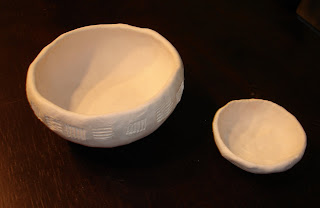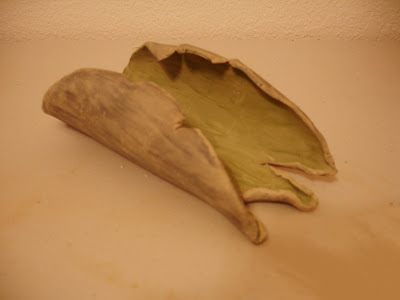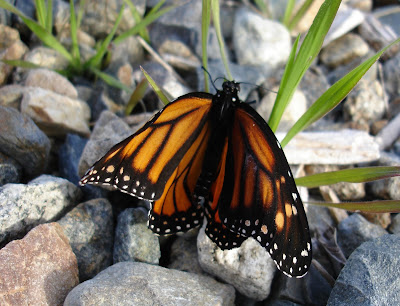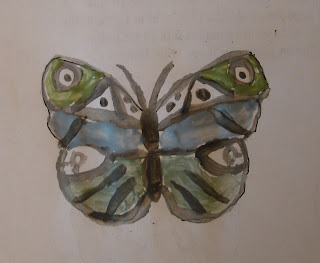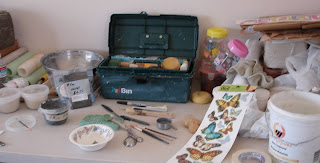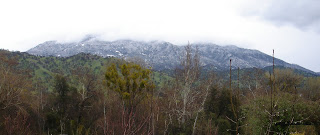
It's bright and sunny and a perfect day for my barrel firing. I already bisqued two pinch pots, two itty-bitty pinch bowls, five sage leaf pendants, and three dusty miller pendants. I prepared each piece of bisque in a different manner. I put some of them in aluminum foil saggars with copper carbonate, copper oxide, red iron oxide, orchid fertilizer (the label said it had a lot of minerals in it), banana peels, chore boys and some miscellaneous ingredients.


Here's how I prepared the barrel. After I obtained a metal 55 gallon drum, I had it steam cleaned. It had contained solvent, so I didn't want to have an explosion or anything. I had the top of the barrel cut out. Just above the bottom of the barrel, I cut two slits about 6 inches in length on opposite sides of the barrel. About one foot up from the bottom of the barrel I had four, four inch squares cut into the metal equal distance apart. The squares were only cut on three sides leaving the bottom of the square attached to the barrel. Then we pushed these squares into the interior of the barrel. These squares allow a metal BBQ grate to stay elevated in the barrel without falling to the bottom. It also allows air to enter the barrel from the sides and keeps the fire burning nice and hot. About a foot up from the squares we drilled holes around the barrel about every six inches or so to let more air in the barrel while it is burning.


Here's how I loaded the barrel. I put a nice bed of straw in the bottom of the barrel and packed it in pretty tight with a shovel. Then I put some kindling and some hickory chips on top of the straw. Next I put in a metal BBQ grate and pushed it down to the metal supports. Next I placed each of my bisque ware pieces on the grate. Then I put some seaweed around the pieces. Next I packed straw around the bisque pieces, then more hickory chips, more kindling, and sprinkled some more of the chemicals. Then I put some split pieces of avocado wood and then I put eucalyptus wood on the very top. This filled the barrel to the top with the top layer of wood extending just over the top of the barrel. I soaked the wood with BBQ lighter fluid. While the fluid was soaking into the wood, I went up to the house to look for a match. It took me forever and then I finally found one of those liquid fire starters and went back and lit the barrel on fire.


There was a little bit of a false start. I lit the barrel and it didn't seem to catch on fire, just a few puffs of smoke. After about five minutes, I was getting rather impatient so I crumpled up some paper bags and pushed a few of them in, put a few more sticks of avocado wood on top and re soaked the wood with more lighter fluid. Then I re-lit the top. Next thing you know the wood catches on fire and starts burning real well. I'm thinking this is a piece of cake. So I pulled up a lawn chair to watch and wait.


After about ten minutes or so the barrel starts to smoke. I think, oh well, that's not so bad, a little smoke is to be expected. Then it starts to smoke a whole bunch. Then it's like a huge smoke screen all around the barn, then way high up in the sky. Since I'm here by myself I'm thinking
Holy Smoke - no pun intended - but wow, what in the heck am I going to say if anyone shows up. I kept looking around to see if anyone in the neighborhood was noticing this huge cloud of gray smoke billowing up into the air hundreds of feet high. I was also hoping the fire department didn't show up. I started looking around to see what my surroundings looked like. I decided to bring my bags of chemicals in the house in case anyone showed up. Besides the smoke was so heavy I decided I didn't want to breathe it. The heavy smoking went on for about ten minutes or so, but it seemed like an eternity. The whole time I'm still thinking,
holy smoke,
holy smoke. Not sure where the expression,
holy smoke, comes from but it sure fit this situation.

Finally the barrel starts to burn real hot with red flames everywhere, thank goodness. The fire stayed flaming for over 45 minutes. I could still see red embers inside the barrel about two hours later. Still a little hot but not glowing three hours later. I took this last shot about four and a half hours later. Everything is all burnt and I can see the outline of the two pinch pots and the itty-bitty bowls, but I can't see any of the pendants. The barrel is barely warm to the touch. So I go in the house to get my pot holders so I can lift the rack out of the barrel.

As I was walking up to the house I saw two monarch butterflies just opening their wings for the first time. Hope that means everything in the barrel does well. Oh, that's the rose for today, number thirty. The story of
holy smoke to be continued tomorrow; I've got to run to class.































